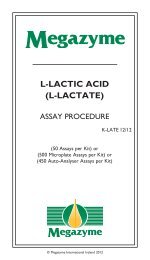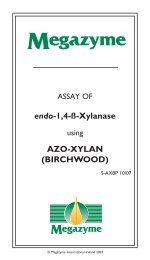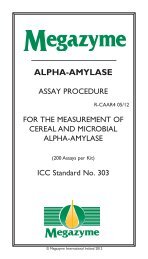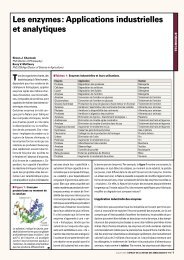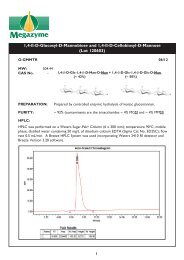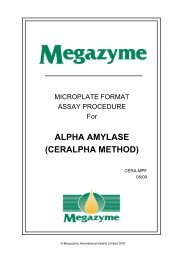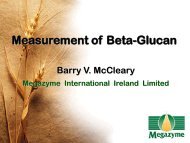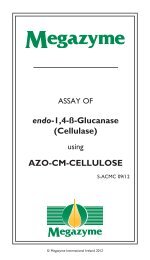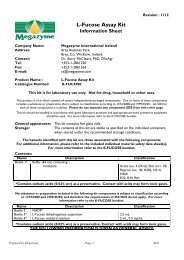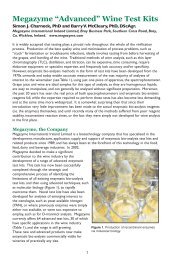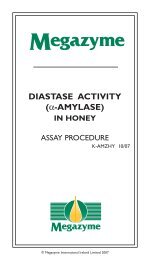LACTOSE and D-Galactose (Rapid) - Megazyme
LACTOSE and D-Galactose (Rapid) - Megazyme
LACTOSE and D-Galactose (Rapid) - Megazyme
You also want an ePaper? Increase the reach of your titles
YUMPU automatically turns print PDFs into web optimized ePapers that Google loves.
MICROPLATE FORMAT<br />
ASSAY PROCEDURE<br />
For<br />
<strong>LACTOSE</strong><br />
<strong>and</strong><br />
D-<strong>Galactose</strong><br />
(<strong>Rapid</strong>)<br />
LACGAR-MPF<br />
06/11<br />
© <strong>Megazyme</strong> International Irel<strong>and</strong> Limited 2011
NOTE:<br />
1. This booklet must be used in conjunction with the the data booklet for<br />
K-LACGAR, downloadable from where the product appears on the <strong>Megazyme</strong><br />
website (www.megazyme.com).<br />
2. Prepare the reagents <strong>and</strong> test samples as described in the data booklet for<br />
K-LACGAR.<br />
2. For each batch of samples that are applied to the microplate format of<br />
K-LACGAR it is highly recommended that a st<strong>and</strong>ard calibration curve is<br />
included on the same microplate.<br />
EQUIPMENT (RECOMMENDED):<br />
1. Disposable 96 well polystyrene clear, flat bottom microplates e.g. Matrix<br />
Technologies Corp. cat. no. 4915 (www.matrixtechcorp.com).<br />
2. Microplate seal.<br />
3. Disposable 25 mL reagent reservoirs, e.g. Matrix Technologies Corp. cat. no.<br />
8093 (www.matrixtechcorp.com).<br />
4. Multichannel Micro-pipettors, e.g. Gilson Pipetman ® Ultra 8-channel (1-20 µL<br />
<strong>and</strong> 20-300 µL).<br />
5. Stop clock.<br />
6. Microplate shaker, e.g. Heidolph Titramax 100 or 1000 (www.heidolphinstruments.com).<br />
7. Microplate reader set at 340 nm.<br />
1
MICROPLATE FORMAT:<br />
Wavelength: 340 nm<br />
Microplate: 96-well (e.g. clear flat-bottomed, glass or plastic)<br />
Temperature: ~ 22°C (ambient)<br />
Final Volume: 0.272 µL<br />
Sample Solution: 0.4-8 µg of D-galactose (or ~ 0.8-16 µg of lactose) per well<br />
(in a 20-100 µL sample volume)<br />
Pippette into wells<br />
Lactose<br />
D-<strong>Galactose</strong><br />
Blank Sample Blank Sample<br />
sample<br />
suspension 4 (β-galactosidase)<br />
-<br />
20 µL<br />
20 µL*<br />
20 µL<br />
-<br />
-<br />
20 µL*<br />
-<br />
Ensure that all of the solutions are delivered to the bottom of the well. Mix**, seal the<br />
wells using microplate seal <strong>and</strong> incubate the plate for approx. 10 min at ~ 25°C.<br />
Add:<br />
distilled water<br />
218 µL<br />
198 µL<br />
238 µL<br />
218 µL<br />
solution 2 (buffer)<br />
solution 3 (NAD + )<br />
20 µL<br />
10 µL<br />
20 µL<br />
10 µL<br />
20 µL<br />
10 µL<br />
20 µL<br />
10 µL<br />
Mix***, read the absorbances of the solutions (A 1 ) after approx. 3 min <strong>and</strong> start the<br />
reaction by addition of:<br />
suspension 5 (β-GalDH/GalM) 4 µL** 4 µL** 4 µL** 4 µL**<br />
Mix***, read the absorbances of the solutions (A 2 ) at the end of the reaction (approx.<br />
5 min). If the reaction has not stopped after 6 min, continue to read the absorbances<br />
at 1 min intervals until the absorbances either remain the same, or increase<br />
constantly over 1 min****.<br />
* where a larger sample volume is required (up to 100 µL) reduce the amount of<br />
distilled water appropriately to maintain the same final volume.<br />
** if preferred, dilute sufficient enzyme for the set of assays 1 in 5 with distilled water,<br />
<strong>and</strong> add 20 µL. Reduce the amount of distilled water appropriately (i.e. by 16 µL), to<br />
maintain the same final volume.<br />
*** for example using microplate shaker, shake function on a microplate reader, or<br />
repeated aspiration (e.g. using pipettor set at 50 - 100 µL volume).<br />
**** if this “creep” rate is greater for the sample than for the blank,<br />
extrapolate the absorbances (sample <strong>and</strong> blank) back to the time of<br />
addition of suspension 5.<br />
2
CALCULATION:<br />
Calculations can be performed as described in the K-LACGAR data booklet* after<br />
appropriate path-length adjustment to 10 mm. This can either be performed<br />
automatically by the plate reader, or after manual determination of the true pathlength<br />
(i.e. by simply performing a “manual” format assay of the st<strong>and</strong>ard solution in a<br />
10 mm cuvette, <strong>and</strong> comparing the absorbance change to that of a reaction<br />
performed according to the “microplate” format). Alternatively a st<strong>and</strong>ard calibration<br />
curve can be used.<br />
NOTE: Where sample readings can be corrected to a 10 mm path-length the<br />
calculations can be simplified by using the <strong>Megazyme</strong> Mega-Calc *.<br />
* available where the product appears on the <strong>Megazyme</strong> website<br />
(www.megazyme.com).<br />
3
<strong>Megazyme</strong> International Irel<strong>and</strong> Ltd.,<br />
Bray Business Park, Bray,<br />
Co. Wicklow,<br />
IRELAND<br />
Telephone : (353.1) 286 1220<br />
Fax : (353.1) 286 1264<br />
Internet : www.megazyme.com<br />
E-Mail : info@megazyme.com<br />
WITHOUT GAURANTEE<br />
The information contained in this booklet is, to the best of our knowledge, true <strong>and</strong> accurate, but since the conditions of use are beyond our control,<br />
no warranty is given or is implied in respect of any recommendation or suggestions which may be made or that any use will not infringe any<br />
patents.<br />
4




